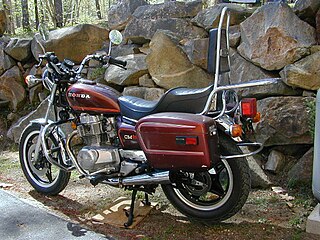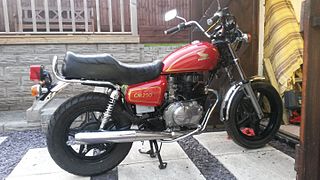
A straight-twin engine, also known as an inline-twin, vertical-twin, or parallel-twin is a two-cylinder piston engine where two cylinders are arranged in a line along a common crankshaft.

The CB Series is an extensive line of Honda motorcycles. Most CB models are road-going motorcycles for commuting and cruising. The smaller CB models are also popular for vintage motorcycle racing. All CB series motorcycles have inline engines. Note: The Honda CBR series are sport bikes.

The Honda CB750 is an air-cooled, transverse, in-line four-cylinder engine motorcycle made by Honda over several generations for year models 1969–2003 as well as 2007 with an upright or standard riding posture. It is often called the original Universal Japanese Motorcycle (UJM).

The Honda Gold Wing is a series of touring motorcycles manufactured by Honda. Gold Wings feature shaft drive and a flat engine. Introduced at the Cologne Motorcycle Show in October 1974, the Gold Wing went on to become a popular model in North America, Western Europe and Australia, as well as Japan.

Universal Japanese Motorcycle (UJM) is a US motorcycling media term for a general-purpose style of Japanese standard motorcycle that revolutionized the industry and made motorcycling in America more accessible during the 1970s and 1980s. By around 1990 its popularity began to wane as the market fragmented into more specialized designs.

A sportbike, or sports bike, is a motorcycle optimized for speed, acceleration, braking, and cornering on paved roads, typically at the expense of comfort and fuel economy by comparison with other motorcycles. Soichiro Honda wrote in the owner's manual of the 1959 Honda CB92 Benly Super Sport that, "Primarily, essentials of the motorcycle consists in the speed and the thrill," while Cycle World's Kevin Cameron says that, "A sportbike is a motorcycle whose enjoyment consists mainly from its ability to perform on all types of paved highway – its cornering ability, its handling, its thrilling acceleration and braking power, even its speed."
The Honda CR series is a range of off-road motorcycles made by the Honda corporation from 1973 onwards.

The Honda CB400F is a motorcycle produced by Honda from 1975 to 1977. It first appeared at the 1974 Cologne motorcycle show, Intermot, and was dropped from the Honda range in 1978. It had an air-cooled, transverse-mounted 408 cc (24.9 cu in) inline four-cylinder engine with two valves per cylinder operated by a single chain-driven overhead camshaft. Fuelling was provided by four 20 mm Keihin carburettors. The CB400F is commonly known as the Honda 400 Four.

The Honda CM400 is a street bike produced by the Honda Motor Company from 1979 to 1982, part of a series of motorcycles with the prefix 'CM' using various engine capacities. It was a precursor to the Honda Rebel series of motorcycles. It was equipped with electric start and electronic ignition. Models included the CM400A (Automatic), CM400C (Custom), CM400E (Economy) and CM400T (Touring). The CM400C was produced only in 1981, making it one of the rarer models.

The Honda CM450A is a motorcycle made by Honda in 1982 and 1983. It was based on the CB400 and CM400 models (1978–1981), especially the CM400A Hondamatic (1980–1981). It had a 447 cc (27.3 cu in) SOHC parallel twin engine with two carburetors and a two-speed transmission with a torque converter. It was not a full automatic, however, because the rider had to manually shift between low and high. It is called automatic because there is no clutch required due to the torque converter, and shared the Hondamatic trade name with Honda cars that had true automatic transmissions. The chain-driven CM450A had a top speed of 90 miles per hour (140 km/h) and weighed 413 pounds (187 kg). Both models had a front disc brake and a rear drum brake. The suspension consisted of two shock absorbers at the rear and telescoping shock-absorbing front forks. The fuel tank had a 3.4 US gallons capacity. The exhaust was routed through a separate pipe and baffle on each side of the motorcycle, although both exhaust pipes shared a plenum under the motor. It had an electric start with a kick start as well.

The Honda CBR400 is a Japanese domestic market small-capacity sport motorcycle, part of the CBR series introduced by Honda in 1983. It is the first Honda motorcycle to wear a CBR badge.

The Honda CM250 is a 234 cc (14.3 cu in) parallel twin cylinder air-cooled OHC four-stroke cruiser motorcycle produced by the Honda corporation from 1981–1983 with a top speed of 85 mph and delivering 70mpg. The 234cc North American market variant was coded as the CM250C and was the precursor to the current Honda CMX250C, also known as the Honda Rebel 250. The European market variant was identified as the CM250TB.
The Honda Dream CB250 was a standard motorcycle made by Honda in 1968 and 1969 and sold only in Japan. It had a 249 cc (15.2 cu in) air-cooled, parallel twin, SOHC, four-stroke with a claimed 30 horsepower (22 kW) at 10,500 rpm. It was Honda's first 250 cc capacity motorcycle with vertical cylinders and a 5-speed transmission.
One of the short-lived lines of Honda motorcycles is the CJ Series, which was an offshoot of the short-lived CB360. The CJ series motorbikes have inline engines, of a nominal 360cc capacity.

The Honda CB400T is a range of motorcycles built by Honda. In the United Kingdom it was known as the Dream, whereas in the United States it was known as the Hawk. A Honda CB250T version was also available for UK licensing reasons.

The Honda SS125A is a motorcycle manufactured by Honda from 1967 through 1969.

The Comstar wheel, sometimes referred to as Com-stars or stylised as ComStar, was a composite motorcycle wheel that Honda fitted to many of its motorcycles from 1977 to the mid 1980s. Its design allowed it the option of being fitted with tubeless tyres and its use on the Honda CX500 was the first time tubeless tyres had been designed for a production motorcycle.

The Honda CB125TD Super Dream is a 124 cc (7.6 cu in) air-cooled, four stroke, twin cylinder motorcycle manufactured by the Honda Motor Company between 1982 and 1988, in three designations, TDC, TDE and TDJ. Intended as a sportier version of the Honda CD125 and CM125 it was similarly restricted to a maximum of 12 hp (8.9 kW), in compliance with the provisional licence requirements of the time, so that it could be used by novice riders.

The Honda 500 twins are a series of straight-twin motorcycles made by Honda since 2013.
















